Wai-Fah Chen.The Civil Engineering Handbook
Подождите немного. Документ загружается.


50-36 The Civil Engineering Handbook, Second Edition
Detailing
The ACI Code specifies that reinforcement in two-way slabs without beams have minimum extensions
as prescribed in Fig. 50.10. Where adjacent spans are unequal, extensions of negative moment reinforcement
FIGURE 50.8 Slab-beam stiffness by equivalent frame method. (Source: ACI Committee 318, 1992.)
B
A
1
n
1
2
2
2
2
2
A
A
B
B
h
c
1
c
1
face of
support
face of
support
h
I
1
/(I − c
2
/
2
)
2
section B-B
Section C-C Section D-D
section E-E
Section A-A
Equivalent
Equivalent slab-beam stiffness
diagram
Equivalent slab-beam stiffness
diagram
(a) Slab system without beams (c) Slab system with column capitals
(b) Slab system with drop panels (d) Slab system with beams
c
1
/
2
c
1
/
2
E
cs
I
1
E
cs
I
1
E
cs
I
2
E
cs
I
1
/(I − c
2
/
2
)
2
E
cs
I
2
/(I − c
2
/
2
)
2
I
1
D
DC
C
E
E
h
2
h
1
h
1
h
1
h
2
I
1
c
1
c
1
I
2
k
2
I
2
/(I − c
2
/
2
)
2
Equivalent
n
c
1
/2c
1
/2
1
A
A
B
B
C
C
h
1
h
1
h
1
h
2
h
2
c
1
face of
support
2
I
1
2
2
Section A-A Section B-B
section C-C
I
2
k
2
I
2
/(I − c
2
/
2
)
2
Equivalent
Equivalent slab-beam stiffness
diagram
E
cs
I
1
E
cs
I
2
E
cs
I
2
/(I − c
2
/
2
)
2
n
c
1
/2c
1
/2
1
2
2
2
2
face of
support
D
D
G
G
E
F
F
E
h
2
h
3
h
1
h
1
h
2
I
1
I
2
h
3
c
1a
c
1b
Section D-D Section E-E
section F-F
I
2
/(I − c
2a
/
2
)
2
I
1
/(I − c
2b
/
2
)
2
Equivalent
section G-G
Equivalent
Equivalent slab-beam stiffness
diagram
E
cs
I
2
E
cs
I
1
E
cs
I
1
/(I − c
2b
/
2
)
2
E
cs
I
2
/(I − c
2a
/
2
)
2
n
c
1b
/2
c
1a
/2
© 2003 by CRC Press LLC
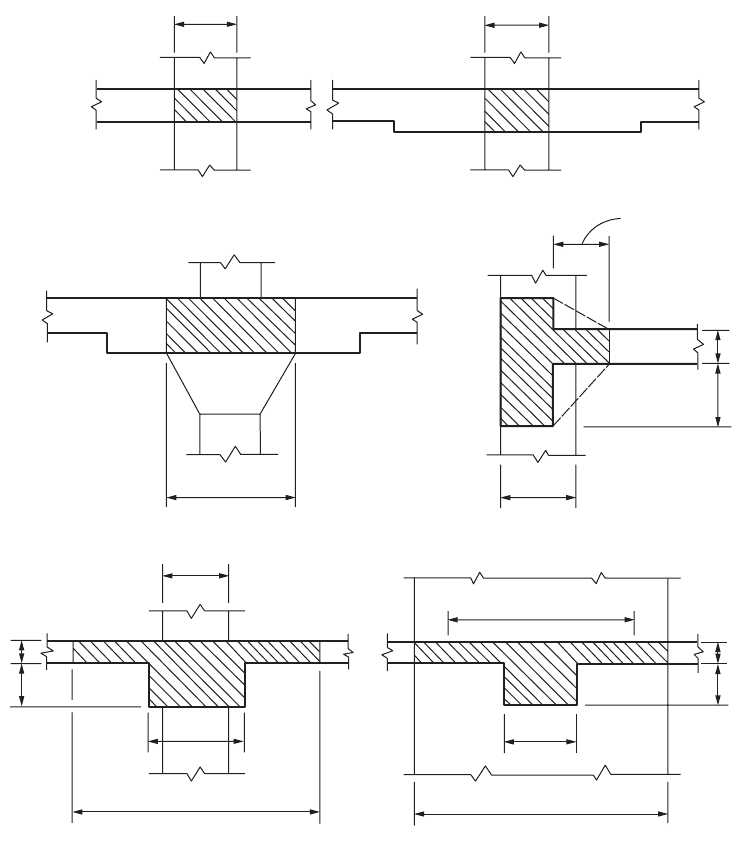
Structural Concrete Design 50-37
shall be based on the longer span. Bent bars may be used only when the depth-span ratio permits use
of bends 45 degrees or less. And at least two of the column strip bottom bars in each direction shall be
continuous or spliced at the support with Class A splices or anchored within support. These bars must
pass through the column and be placed within the column core. The purpose of this “integrity steel” is
to give the slab some residual capacity following a single punching shear failure.
The ACI Code requires drop panels to extend in each direction from centerline of support a distance
not less than one-sixth the span length, and the drop panel must project below the slab at least one-
quarter of the slab thickness. The effective support area of a column capital is defined by the intersection
of the bottom surface of the slab with the largest right circular cone whose surfaces are located within
the column and capital and are oriented no greater than 45 degrees to the axis of the column.
FIGURE 50.9 To rsional members. (Source: ACI Committee 318, 1992.)
Condition (a) Condition (a)
Condition (a) Condition (c)
Condition (c) Condition (b)
c
1
c
1
c
1
c
1
c
1
c
1
h
w
<_ 4h
f
h
w
b
w
h
f
h
w
h
f
h
w
h
f
b
w
+ 2h
w
<_b
w
+ 8h
f
b
w
+ 2h
w
<_b
w
+ 8h
f
b
w
© 2003 by CRC Press LLC
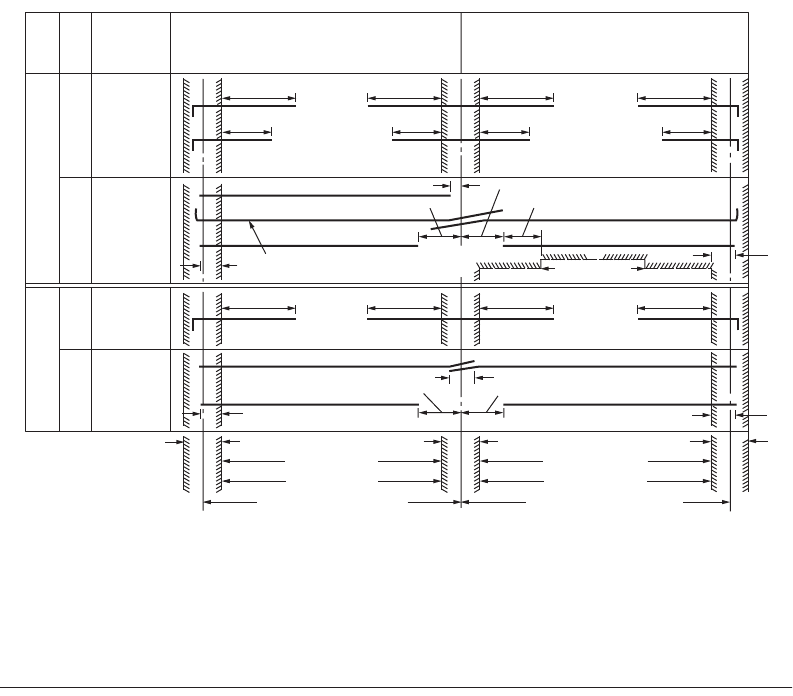
50-38 The Civil Engineering Handbook, Second Edition
50.8 Frames
A structural frame is a three-dimensional structural system consisting of straight members that are built
monolithically and have rigid joints. The frame may be one bay long and one story high — such as portal
frames and gable frames — or it may consist of multiple bays and stories. All members of the frame are
considered continuous in the three directions, and the columns participate with the beams in resisting
external loads.
Consideration of the behavior of reinforced concrete frames at and near the ultimate load is necessary
to determine the possible distributions of bending moment, shear force, and axial force that could be used
in design. It is possible to use a distribution of moments and forces different from that given by linear elastic
structural analysis if the critical sections have sufficient ductility to allow redistribution of actions to occur
as the ultimate load is approached. Also, in countries that experience earthquakes, a further important
design is the ductility of the structure when subjected to seismic-type loading, since present seismic design
philosophy relies on energy dissipation by inelastic deformations in the event of major earthquakes.
Analysis of Frames
A number of methods have been developed over the years for the analysis of continuous beams and
frames. The so-called classical methods — such as application of the theorem of three moments, the
method of least work, and the general method of consistent deformation — have proved useful mainly
in the analysis of continuous beams having few spans or of very simple frames. For the more complicated
cases usually met in practice, such methods prove to be exceedingly tedious, and alternative approaches
are preferred. For many years the closely related methods of slope deflection and moment distribution
provided the basic analytical tools for the analysis of indeterminate concrete beams and frames. In offices
FIGURE 50.10 Minimum extensions for reinforcement in two-way slabs without beams. (Source: ACI Committee
318, 1992.)
0.30
n
0.30
n
0.33
n
0.20
n
0.20
n
0.20
n
0.22
n
0.22
n
0.22
n
0.22
n
0.20
n
0.33
n
MIDDLE STRIP COLUMN STRIP STRIP
LOCATIONTOPBOTTOMBOTTOM TOP
50
100
Remainder
50
Remainder
50
Remainder
WITHOUT DROP PANELS WITH DROP PANELS
MINIMUM
PERCENT-A
S
AT SECTION
Clear span -
n
Face of support
Center to center span -
Clear span -
n
Face of support
Center to center span -
C
1
C
1
C
1
6"
6"
6"
6"
6"
Max. 0.15
Max. 0.125
1
Max. 0.125
1
Max. 0.15
24 bar dia. or 12" min. all bars
At least 2 bars continuous or anchored
as required in Section 13.4.8.5
Edge of drop
3" max.
Exterior support
(No slab continuity)
c
L
Interior support
(Continuity provided)
c
L
Exterior support
(No slab continuity)
c
L
© 2003 by CRC Press LLC
Structural Concrete Design 50-39
with access to high-speed digital computers, these have been supplanted largely by matrix methods of
analysis. Where computer facilities are not available, moment distribution is still the most common
method. Approximate methods of analysis, based either on an assumed shape of the deformed structure
or on moment coefficients, provide a means for rapid estimation of internal forces and moments. Such
estimates are useful in preliminary design and in checking more exact solutions, and in structures of
minor importance may serve as the basis for final design.
Slope Deflection
The method of slope deflection entails writing two equations for each member of a continuous frame,
one at each end, expressing the end moment as the sum of four contributions: (1) the restraining moment
associated with an assumed fixed-end condition for the loaded span, (2) the moment associated with
rotation of the tangent to the elastic curves at the near end of the member, (3) the moment associated
with rotation of the tangent at the far end of the member, and (4) the moment associated with translation
of one end of the member with respect to the other. These equations are related through application of
requirements of equilibrium and compatibility at the joints. A set of simultaneous, linear algebraic
equations results for the entire structure, in which the structural displacements are unknowns. Solution
for these displacements permits the calculation of all internal forces and moments.
This method is well suited to solving continuous beams, provided there are not very many spans. Its
usefulness is extended through modifications that take advantage of symmetry and antisymmetry, and
of hinge-end support conditions where they exist. However, for multistory and multibay frames in which
there are a large number of members and joints, and which will, in general, involve translation as well
as rotation of these joints, the effort required to solve the correspondingly large number of simultaneous
equations is prohibitive. Other methods of analysis are more attractive.
Moment Distribution
The method of moment distribution was developed to solve problems in frame analysis that involve
many unknown joint displacements. This method can be regarded as an iterative solution of the slope-
deflection equations. Starting with fixed-end moments for each member, these are modified in a series
of cycles, each converging on the precise final result, to account for rotation and translation of the joints.
The resulting series can be terminated whenever one reaches the degree of accuracy required. After
obtaining member-end moments, all member stress resultants can be obtained by use of the laws of statics.
Matrix Analysis
Use of matrix theory makes it possible to reduce the detailed numerical operations required in the analysis
of an indeterminate structure to systematic processes of matrix manipulation, which can be performed
automatically and rapidly by computer. Such methods permit the rapid solution of problems involving
large numbers of unknowns. As a consequence, less reliance is placed on special techniques limited to
certain types of problems; powerful methods of general applicability have emerged, such as the matrix
displacement method. Account can be taken of such factors as rotational restraint provided by members
perpendicular to the plane of a frame. A large number of alternative loadings may be considered. Provided
that computer facilities are available, highly precise analyses are possible at lower cost than for approx-
imate analyses previously employed.
Approximate Analysis
In spite of the development of refined methods for the analysis of beams and frames, increasing attention
is being paid to various approximate methods of analysis. There are several reasons for this. Prior to
performing a complete analysis of an indeterminate structure, it is necessary to estimate the proportions
of its members in order to know their relative stiffness upon which the analysis depends. These dimensions
can be obtained using approximate analysis. Also, even with the availability of computers, most engineers
find it desirable to make a rough check of results — using approximate means — to detect gross errors.
Further, for structures of minor importance, it is often satisfactory to design on the basis of results
obtained by rough calculation.
© 2003 by CRC Press LLC
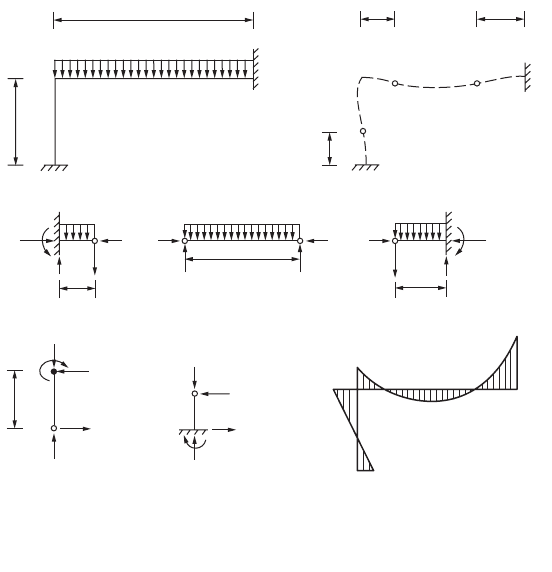
50-40 The Civil Engineering Handbook, Second Edition
Provided that points of infection (locations in members at which the bending moment is zero and
there is a reversal of curvature of the elastic curve) can be located accurately, the stress resultants for a
frame structure can usually be found on the basis of static equilibrium alone. Each portion of the structure
must be in equilibrium under the application of its external loads and the internal stress resultants. The
use of approximate analysis in determining stress resultants in frames is illustrated using a simple rigid
frame in Fig. 50.11.
ACI Moment Coefficients
The ACI Code [ACI Committee 318, 1992] includes moment and shear coefficients that can be used for
the analysis of buildings of usual types of construction, span, and story heights. They are given in ACI
Code Sec. 8.3.3. The ACI coefficients were derived with due consideration of several factors: a maximum
allowable ratio of live to dead load (3:1); a maximum allowable span difference (the larger of two adjacent
spans not exceed the shorter by more than 20%); the fact that reinforced concrete beams are never simply
supported but either rest on supports of considerable width, such as walls, or are built monolithically
like columns; and other factors. Since all these influences are considered, the ACI coefficients are neces-
sarily quite conservative, so that actual moments in any particular design are likely to be considerably
smaller than indicated. Consequently, in many reinforced concrete structures, significant economy can
be effected by making a more precise analysis.
Limit Analysis
Limit analysis in reinforced concrete refers to the redistribution of moments that occurs throughout a
structure as the steel reinforcement at a critical section reaches its yield strength. Under working loads,
the distribution of moments in a statically indeterminate structure is based on elastic theory and the
whole structure remains in the elastic range. In limit design, where factored loads are used, the distri-
bution of moments at failure when a mechanism is reached is different from that distribution based on
FIGURE 50.11 Approximate analysis of rigid frame. (Source: Nilson and Winter, 1992.)
12'
2'
3'
2'
2'
3'
4'
6'
B
B
PPP PPP
EI
= constant
A
C
C
w
= 2
k
/1
2
k
/1
2
k
/1
2
k
/1
(a)
(c) (d) (e)
(f) (g) (h)
(b)
18'
k
18'
k
7
k
7
k
7
k
7
'
7
k
13
k
30'
k
30'
k
18'
k
9'
k
9'
k
11
k
11
k
11
k
11
k
11
k
4.5
k
4.5
k
4.5
k
4.5
k
0
© 2003 by CRC Press LLC
Structural Concrete Design 50-41
elastic theory. The ultimate strength of the structure can be increased as more sections reach their ultimate
capacity. Although the yield of the reinforcement introduces large deflections, which should be avoided
under service, a statically indeterminate structure does not collapse when the reinforcement of the first
section yields. Furthermore, a large reserve of strength is present between the initial yielding and the
collapse of the structure.
In steel design the term plastic design is used to indicate the change in the distribution of moments
in the structure as the steel fibers, at a critical section, are stressed to their yield strength. Limit analysis
of reinforced concrete developed as a result of earlier research on steel structures. Several studies had
been performed on the principles of limit design and the rotation capacity of reinforced concrete plastic
hinges.
Full utilization of the plastic capacity of reinforced concrete beams and frames requires an extensive
analysis of all possible mechanisms and an investigation of rotation requirements and capacities at all
proposed hinge locations. The increase of design time may not be justified by the limited gains obtained.
On the other hand, a restricted amount of redistribution of elastic moments can safely be made without
complete analysis and may be sufficient to obtain most of the advantages of limit analysis.
A limited amount of redistribution is permitted under the ACI Code, depending upon a rough measure
of available ductility, without explicit calculation of rotation requirements and capacities. The ratio
r/r
b
— or in the case of doubly reinforced members, (r – r¢)/r
b
— is used as an indicator of rotation
capacity, where r
b
is the balanced steel ratio. For singly reinforced members with r = r
b
, experiments
indicate almost no rotation capacity, since the concrete strain is nearly equal to e
cu
when steel yielding
is initiated. Similarly, in a doubly reinforced member, when r – r¢ = r
b
, very little rotation will occur
after yielding before the concrete crushes. However, when r or r – r¢ is low, extensive rotation is usually
possible. Accordingly, ACI Code Sec. 8.3 provides as follows:
Except where approximate values for moments are used, it is permitted to increase or decrease negative
moments calculated by elastic theory at supports of continuous flexural members for any assumed
loading arrangement by not more than 20[1 – (r – r¢)/r
b
] percent. The modified negative moments
shall be used for calculating moments at sections within the spans. Redistribution of negative moments
shall be made only when the section at which moment is reduced is so designed that r or r – r¢ is
not greater than 0.5r
b
[1992].
Design for Seismic Loading
The ACI Code contains provisions that are currently considered to be the minimum requirements for
producing a monolithic concrete structure with adequate proportions and details to enable the structure
to sustain a series of oscillations into the inelastic range of response without critical decay in strength.
The provisions are intended to apply to reinforced concrete structures located in a seismic zone where
major damage to construction has a high possibility of occurrence, and are designed with a substantial
reduction in total lateral seismic forces due to the use of lateral load-resisting systems consisting of ductile
moment-resisting frames. The provisions for frames are divided into sections on flexural members,
columns, and joints of frames. Some of the important points stated are summarized below.
Flexural Members
Members having a factored axial force not exceeding A
g
f ¢
c
/10, where A
g
is gross section of area (in.
2
), are
regarded as flexural members. An upper limit is placed on the flexural steel ratio r. The maximum value
of r should not exceed 0.025. Provision is also made to ensure that a minimum quantity of top and
bottom reinforcement is always present. Both the top and the bottom steel are to have a steel ratio of at
least 200/f
y
, with the steel yield strength f
y
in psi throughout the length of the member. Recommendations
are also made to ensure that sufficient steel is present to allow for unforeseen shifts in the points of
contraflexure. At column connections, the positive moment capacity should be at least 50% of the negative
moment capacity, and the reinforcement should be terminated in the far face of the column using a hook
plus any additional extension necessary for anchorage.
© 2003 by CRC Press LLC

50-42 The Civil Engineering Handbook, Second Edition
The design shear force V
e
should be determined from consideration of the static forces on the portion
of the member between faces of the joints. It should be assumed that moments of opposite sign corre-
sponding to probable strength M
pr
act at the joint faces and that the member is loaded with the factored
tributary gravity load along its span. Figure 50.12 illustrates the calculation. Minimum web reinforcement
is provided throughout the length of the member, and spacing should not exceed d/4 in plastic hinge
zones and d/2 elsewhere, where d is effective depth of member. The stirrups should be closed around
bars required to act as compression reinforcement and in plastic hinge regions, and the spacing should
not exceed specified values.
Columns
Members having a factored axial force exceeding A
g
f ¢
c
/10 are regarded as columns of frames serving to
resist earthquake forces. These members should satisfy the conditions that the shortest cross-sectional
dimension — measured on a straight line passing through the geometric centroid — should not be less
than 12 in. and that the ratio of the shortest cross-sectional dimension to the perpendicular dimension
should not be less than 0.4. The flexural strengths of the columns should satisfy
(50.115)
FIGURE 50.12 Design shears for girders and columns. (Source: ACI 318, 1992.)
Design gravity load
End moments M
pr
based on steel tensile stress = 1.25 fy
where fy is the specified yield strength.(Both end moments
should be considered in both directions, clockwise and
counter clockwise)
End moments M
pr
based on steel tensile stress = 1.25 fy
where fy is the specified yield strength.(Both end moments
should be considered in both directions, clockwise and
counter clockwise)
Direction of shear force V
e
depends on relative magnitudes
of gravity loads and shear
generated by end moments.
W
L
V
e
V
e
V
e
V
e
M
pr1
M
pr2
M
pr1
P
M
pr2
P
H
Note: End moments M
pr
for columns need not be greater
than moments generated by the M
pr
of the beams
framing into the beam-column points. V
e
shall never be
less than that required by analysis of the structure.
V
e
=
W
2
=
L
M
pr1
M
pr2
+
V
e
=
H
M
pr1
M
pr2
+
MM
eg
ÂÂ
≥
()
65
© 2003 by CRC Press LLC

Structural Concrete Design 50-43
where  M
e
is sum of moments, at the center of the joint, corresponding to the design flexural strength
of the columns framing into that joint and where  M
g
is sum of moments, at the center of the joint,
corresponding to the design flexural strengths of the girders framing into that joint. Flexural strengths
should be summed such that the column moments oppose the beam moments. Eq. (50.115) should be
satisfied for beam moments acting in both directions in the vertical plane of the frame considered. The
requirement is intended to ensure that plastic hinges form in the girders rather than the columns.
The longitudinal reinforcement ratio is limited to the range of 0.01 to 0.06. The lower bound to the
reinforcement ratio refers to the traditional concern for the effects of time-dependent deformations of
the concrete and the desire to have a sizable difference between the cracking and yielding moments. The
upper bound reflects concern for steel congestion, load transfer from floor elements to column in low-
rise construction, and the development of large shear stresses. Lap splices are permitted only within the
center half of the member length and should be proportioned as tension splices. Welded splices and
mechanical connections are allowed for splicing the reinforcement at any section, provided not more
than alternate longitudinal bars are spliced at a section and the distance between splices is 24 in. or more
along the longitudinal axis of the reinforcement.
If Eq. (50.115) is not satisfied at a joint, columns supporting reactions from that joint should be
provided with transverse reinforcement over their full height to confine the concrete and provide lateral
support to the reinforcement. Where a spiral is used, the ratio of volume of spiral reinforcement to the
core volume confined by the spiral reinforcement, r
s
, should be at least that given by
(50.116)
but not less than 0.12 f ¢
c
/f
yh
,where A
c
is the area of core of spirally reinforced compression member
measured to outside diameter of spiral in in.
2
and f
yh
is the specified yield strength of transverse rein-
forcement in psi. When rectangular reinforcement hoop is used, the total cross-sectional area of rectan-
gular hoop reinforcement should not be less than that given by
(50.117)
(50.118)
where s is the spacing of transverse reinforcement measured along the longitudinal axis of column, h
c
is
the cross-sectional dimension of column core measured center-to-center of confining reinforcement, and
A
sh
is the total cross-sectional area of transverse reinforcement (including crossties) within spacing s and
perpendicular to dimension h
c
. Supplementary crossties, if used, should be of the same diameter as the
hoop bar and should engage the hoop with a hook. Special transverse confining steel is required for the
full height of columns that support discontinuous shear walls.
The design shear force V
c
should be determined from consideration of the maximum forces that can
be generated at the faces of the joints at each end of the column. These joint forces should be determined
using the maximum probable moment strength M
pr
of the column associated with the range of factored
axial loads on the column. The column shears need not exceed those determined from joint strengths
based on the probable moment strength M
pr
, of the transverse members framing into the joint. In no
case should V
e
be less than the factored shear determined by analysis of the structure (Fig. 50.12).
Joints of Frames
Development of inelastic rotations at the faces of reinforced concrete frames is associated with strains in
the flexural reinforcement well in excess of the yield strain. Consequently, joint shear force generated by
the flexural reinforcement is calculated for a stress of 1.25f
y
in the reinforcement.
r
s
c
y
g
c
f
f
A
A
=
¢
-
Ê
Ë
Á
ˆ
¯
˜
045 1.
AshffAA
sh c c yh g ch
=
¢
()()
-
[]
03 1.
Ashff
sh c c yh
=
¢
009.
© 2003 by CRC Press LLC
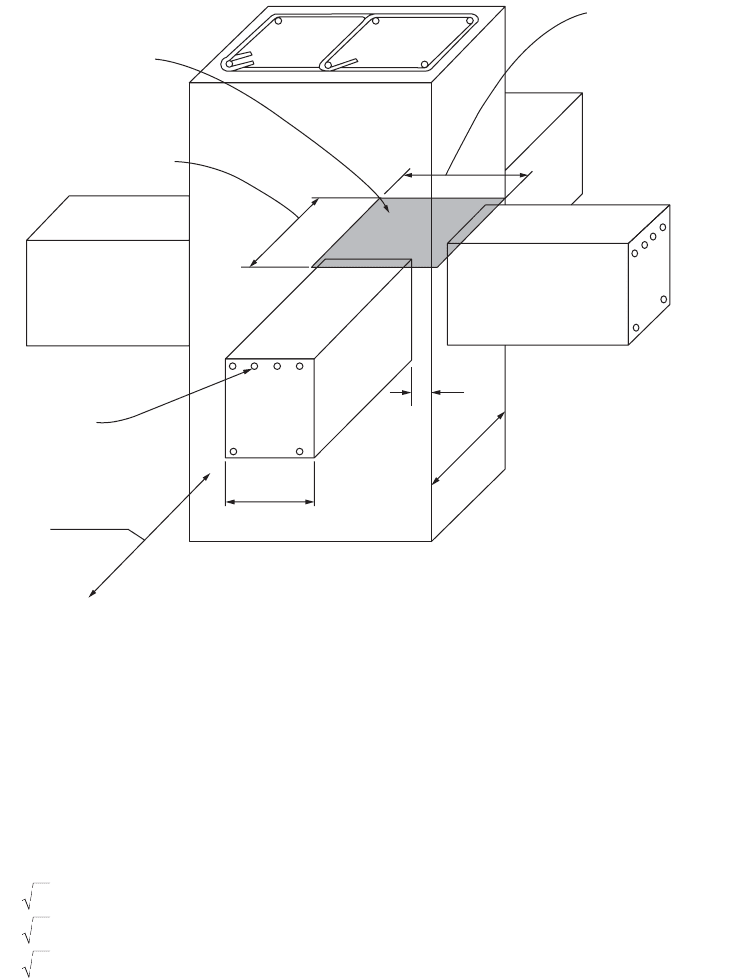
50-44 The Civil Engineering Handbook, Second Edition
Within the depth of the shallowed framing member, transverse reinforcement equal to at least one-
half the amount required for the column reinforcement should be provided where members frame into
all four sides of the joint and where each member width is at least three-fourths the column width.
Transverse reinforcement as required for the column reinforcement should be provided through the joint
to provide confinement for longitudinal beam reinforcement outside the column core if such confinement
is not provided by a beam framing into the joint.
The nominal shear strength of the joint should not be taken greater than the forces specified below
for normal weight aggregate concrete:
20 for joints confined on all four faces
15 for joints confined on three faces or on two opposite faces
12 for others
where A
j
is the effective cross-sectional area within a joint in a plane parallel to plane of reinforcement
generating shear in the joint (see Fig. 50.13). A member that frames into a face is considered to provide
confinement to the joint if at least three-quarters of the face of the joint is covered by the framing member.
A joint is considered to be confined if such confining members frame into all faces of the joint. For
lightweight-aggregate concrete, the nominal shear strength of the joint should not exceed three-quarters
of the limits given above.
Details of minimum development length for deformed bars with standard hooks embedded in normal
and lightweight concrete and for straight bars are contained in ACI Code Sec. 21.6.4.
FIGURE 50.13 Effective area of joint. (Source: ACI Committee 318, 1992.)
Effective
joint width ≤ b + h
≤ b + 2x
x
h
b
Effective area
Joint depth = h
in plane of
reinforcement
generating shear
Reinforcement
generating shear
Direction of
forces generating
shear
Note: Effective area of joint for forces
in each direction of framing is to
be considered separately.
Joint illustrated does not meet
conditions of Sections 21.6.2.2
and 21.6.3.1 necessary to be
considered confined because
the framing members do not
cover at least
3
/4 of each of the
joints.
¢
fA
c
j
¢
fA
c
j
¢
fA
c
j
© 2003 by CRC Press LLC
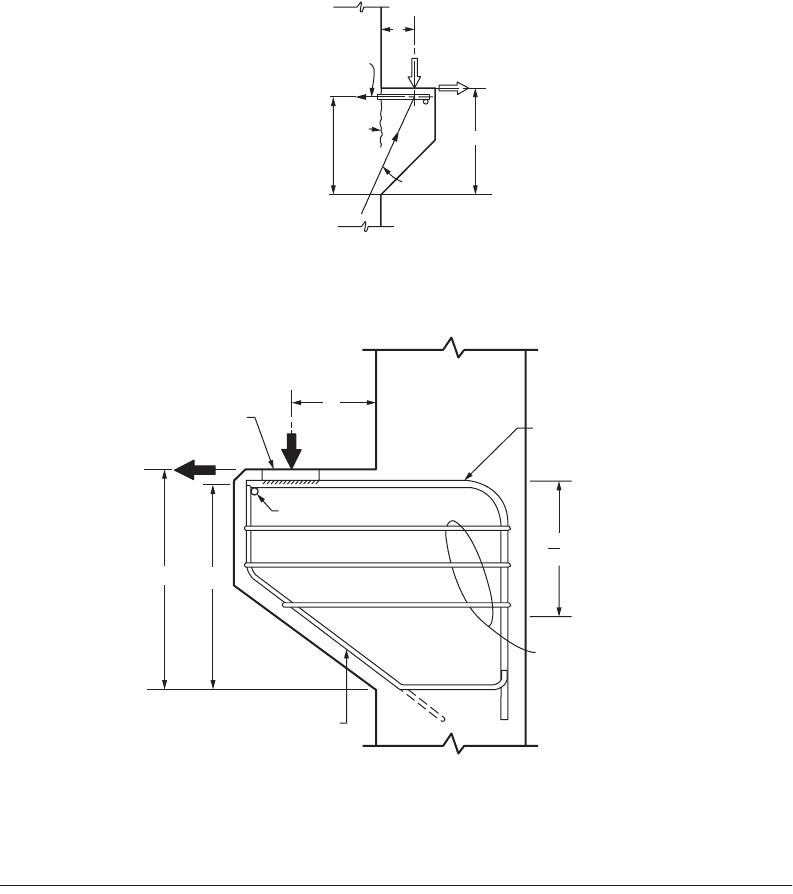
Structural Concrete Design 50-45
50.9 Brackets and Corbels
Brackets and corbels are cantilevers having shear span to depth ratio, a/d, not greater than unity. The
shear span a is the distance from the point of load to the face of support, and the distance d shall be
measured at face of support (see Fig. 50.14).
The corbel shown in Fig. 50.14 may fail by shearing along the interface between the column and the
corbel, by yielding of the tension tie, by crushing or splitting of the compression strut, or by localized
bearing or shearing failure under the loading plate.
The depth of a bracket or corbel at its outer edge should be less than one-half of the required depth
d at the support. Reinforcement should consist of main tension bars with area A
s
and shear reinforcement
with area A
h
(see Fig. 50.15 for notation). The area of primary tension reinforcement A
s
should be made
equal to the greater of (A
f
+ A
n
) or (2A
vf
/3 + A
n
), where A
f
is the flexural reinforcement required to resist
moment [V
u
a + N
uc
(h – d)], A
n
is the reinforcement required to resist tensile force N
uc
, and A
vf
is the
shear-friction reinforcement required to resist shear V
u
:
FIGURE 50.14 Structural action of a corbel. (Source: ACI Committee 318, 1992.)
FIGURE 50.15 Notation used. (Source: ACI Committee 318, 1992.)
Tension tie
fA
s
f
y
h
a
d
V
u
N
uc
Compression
strut
Shear
plane
h
d
a
bearing
plate
V
u
N
uc
anchor bar
A
s
(primary
reinforcement)
A
h
(closed
stirrups or ties)
2
3
d
Framing bar to anchor
stirrups or ties
© 2003 by CRC Press LLC
